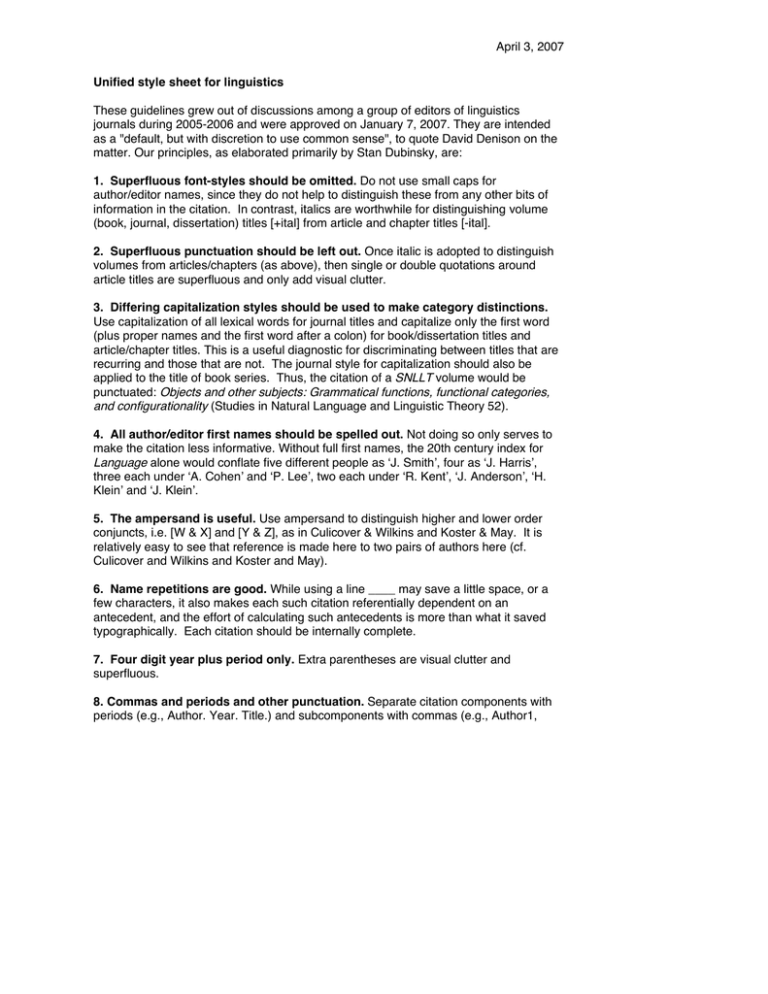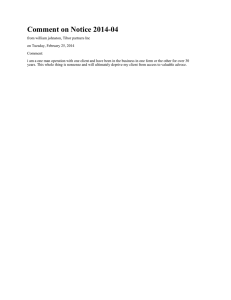April 3, 2007
advertisement

April 3, 2007 Unified style sheet for linguistics These guidelines grew out of discussions among a group of editors of linguistics journals during 2005-2006 and were approved on January 7, 2007. They are intended as a "default, but with discretion to use common sense", to quote David Denison on the matter. Our principles, as elaborated primarily by Stan Dubinsky, are: 1. Superfluous font-styles should be omitted. Do not use small caps for author/editor names, since they do not help to distinguish these from any other bits of information in the citation. In contrast, italics are worthwhile for distinguishing volume (book, journal, dissertation) titles [+ital] from article and chapter titles [-ital]. 2. Superfluous punctuation should be left out. Once italic is adopted to distinguish volumes from articles/chapters (as above), then single or double quotations around article titles are superfluous and only add visual clutter. 3. Differing capitalization styles should be used to make category distinctions. Use capitalization of all lexical words for journal titles and capitalize only the first word (plus proper names and the first word after a colon) for book/dissertation titles and article/chapter titles. This is a useful diagnostic for discriminating between titles that are recurring and those that are not. The journal style for capitalization should also be applied to the title of book series. Thus, the citation of a SNLLT volume would be punctuated: Objects and other subjects: Grammatical functions, functional categories, and configurationality (Studies in Natural Language and Linguistic Theory 52). 4. All author/editor first names should be spelled out. Not doing so only serves to make the citation less informative. Without full first names, the 20th century index for Language alone would conflate five different people as ‘J. Smith’, four as ‘J. Harris’, three each under ‘A. Cohen’ and ‘P. Lee’, two each under ‘R. Kent’, ‘J. Anderson’, ‘H. Klein’ and ‘J. Klein’. 5. The ampersand is useful. Use ampersand to distinguish higher and lower order conjuncts, i.e. [W & X] and [Y & Z], as in Culicover & Wilkins and Koster & May. It is relatively easy to see that reference is made here to two pairs of authors here (cf. Culicover and Wilkins and Koster and May). 6. Name repetitions are good. While using a line ____ may save a little space, or a few characters, it also makes each such citation referentially dependent on an antecedent, and the effort of calculating such antecedents is more than what it saved typographically. Each citation should be internally complete. 7. Four digit year plus period only. Extra parentheses are visual clutter and superfluous. 8. Commas and periods and other punctuation. Separate citation components with periods (e.g., Author. Year. Title.) and subcomponents with commas (e.g., Author1, 2 Author2 & Author3). Please note the ampersand (&), rather than the word “and” before the name of the last author, and no comma before the “&”. The use of the colon between title and subtitle and between place and publisher is traditional, but we do not use it between journal volumenumber and pagenumbers. 9. Parentheses around ed. makes sense. Commas and periods should be used exclusively to separate citation components (e.g., "Author. Year."), or subcomponents (e.g. "author1, author2 & author3). Since "ed." is neither a component nor a subcomponent, but a modifier of a component, it should not be separated from the name by a comma: surname, firstname = author surname, firstname (ed.). = editor (NOT surname, firstname, ed.) surname, firstname & firstname surname (eds.) = editors 10. For conference proceedings, working papers, etc. For conference proceedings published with an ISSN, treat the proceedings as a journal: Include both the full conference name and any commonly used acronym for the conference (BLS, WCCFL, etc.) in the journal title position. For proceedings not published with an ISSN, treat the proceedings as any other book, using the full title as listed on the front cover or title page. If the title (and subtitle if there is one) only includes an acronym for the conference name, expand the acronym in square brackets or parentheses following the acronym. If the title does not include an acronym which is commonly used for the conference name, include the acronym in square brackets or parentheses following the conference name. The advantage of including the acronym after the society title is that it makes the entry much more identifiable in a list of references. 11. Use “edn.” as an abbreviation for “edition”, thus “2nd edn.”. This avoids ambiguity and confusion with “ed.” (editor). 12. Names with “von”, “van”, “de”, etc. If the "van" (or the "de" or other patronymic) is lower case and separated from the rest by a space (e.g. Elly van Gelderen), then alphabetize by the first upper-case element: Gelderen, Elly van The addition of "see ..." in comprehensive indices and lists might be helpful for clarification: van Gelderen, Elly (see Gelderen) 13. Names with “Jr.”, “IV.”, etc. Following library practice, list elements such as “Jr.” as a subelement after names, separated by a comma. Smith, Sean, Jr. 3 14. Use “In” to designate chapters in collections. This makes the book’s format maximally similar to the standard citation format. This, in turn, would be time-saving when the author or the editor notice that more than one article is cited from a given collection and hence that that book’s details should be set out as a separate entry in the references (and the full details deleted from the articles’ entries). author. year. chaptertitle. In editorname (ed.), collectiontitle, pagenumbers. publisher. 15. Journal volume numbers. We favor: volumenumber(volumeissue). startingpageendingpage. Thus: 22(1). 135-169. Note the space between volume number/issue and page numbers. Special formatting (e.g., bold for volume number) is superfluous. Issue numbers are a parenthetical modifier (cf. "ed." above) of the volume number. While it is not NECESSARY information for identifying the article, it is extremely USEFUL information. 16. Dissertations/theses. These conform to the already-widespread Place: Publisher format and fit readily into the rest of the standard: Cambridge, MA: MIT dissertation. Instead of archaic state abbreviations, use the official two-letter postal abbreviations. Note that national and other traditions vary in exactly what is labeled ‘thesis’ versus ‘dissertation’ and in distinguishing ‘PhD’ from ‘doctoral’ dissertations. Cambridge, MA: MIT dissertation. Chapel Hill: UNC MA thesis. 17. On-line materials. The basic information here — author, date, title — remains the same, and the URL where the resource was found takes the place of publisher or journal. We urge authors to include the date the material was accessed, in parentheses after the URL, since new versions often replace old ones. For a .pdf file, this would be the date of downloading, but for a resource like an on-line dictionary consulted repeatedly, a range of dates may be needed. For additional discussion of handling online citations, authors may want to consult this guide: Walker, Janice R. & Todd Taylor. 1998. The Columbia Guide to Online Style. New York: Columbia University Press. Joseph Salmons! 5/12/05 12:14 PM Comment: No use of caps/small caps for author/editor names. Joseph Salmons! 5/12/05 12:34 PM Comment: Capitalize only the first word of a book/dissertation title (plus proper names and the first word after a colon). Joseph Salmons! 6/1/05 2:26 PM Comment: Call conference proceedings titles according to the name of the society, including the meeting’s acronym in parentheses. Do not include “proceedings of the” or “papers from the”. Joseph Salmons! 6/6/05 2:13 PM Comment: Author/editor first names should be spelled out (recommended, but not obligatory). Joseph Salmons! 5/12/05 12:21 PM Example references Comment: Four digit year plus period only; no parentheses. Blevins, Juliette. 2004. Evolutionary phonology. Cambridge: Cambridge University Joseph Salmons! 6/6/05 2:13 PM Press. Comment: alphabetize names with “von”, Casali, Roderic F. 1998. Predicting ATR activity. Chicago Linguistic Society (CLS) “van”, “de”, etc. according to first upper-case 34(1). 55-68. element. Chomsky, Noam. 1986. Knowledge of language. New York: Praeger. Joseph Salmons! 4/1/07 10:28 AM Coetsem, Frans van. 2000. A general and unified theory of the transmission process in Comment: For on-line materials, give the date the resource was accessed. language contact. Heidelberg: Winter. Joseph Salmons! 5/15/05 11:51 AM Franks, Steven. 2005. Bulgarian clitics are positioned in the syntax. http://www.cogs.indiana.edu/people/homepages/franks/Bg_clitics_remark_dense.pdf Comment: No italics with article titles. Joseph Salmons! 5/15/05 11:56 AM (17 May, 2006.) Comment: Capitalize all lexical words in Iverson, Gregory K. 1983. Korean /s/. Journal of Phonetics 11. 191-200. journal or series titles. 4 Iverson, Gregory K. 1989. On the category supralaryngeal. Phonology 6. 285-303. Johnson, Kyle, Mark Baker & Ian Roberts. 1989. Passive arguments raised. Linguistic Inquiry 20. 219-251. Lahiri, Aditi (ed.). 2000. Analogy, leveling, markedness: Principles of change in phonology and morphology (Trends in Linguistics 127). Berlin: Mouton de Gruyter. McCarthy, John J. & Alan S. Prince. 1999. Prosodic morphology. In John A. Goldsmith (ed.), Phonological theory: The essential readings, 238-288. Malden, MA & Oxford: Blackwell. Murray, Robert W. & Theo Vennemann. 1983. Sound change and syllable structure in Germanic phonology. Language 59(3). 514-528. Oxford English Dictionary, 2nd edn. 1989. Oxford: Oxford University Press. Pedersen, Johan. 2005. The Spanish impersonal se-construction: Constructional variation and change. Constructions 1, http://www.constructions-online.de. (3 April, 2007.) Rissanen, Matti. 1999. Syntax. In Roger Lass (ed.), Cambridge History of the English Language, vol. 3, 187-331. Cambridge & New York: Cambridge University Press. Stewart, Thomas W., Jr. 2000. Mutation as morphology: Bases, stems, and shapes in Scottish Gaelic. Columbus, OH: The Ohio State University dissertation. Webelhuth, Gert (ed.). 1995. Government and binding theory and the minimalist program: Principles and parameters in syntactic theory. Oxford: Blackwell. Yu, Alan C. L. 2003. The morphology and phonology of infixation. Berkeley, CA: University of California dissertation. Joseph Salmons! 5/15/05 11:50 AM Comment: Repeat names for each entry. Joseph Salmons! 5/12/05 12:23 PM Comment: Comma used to separate subcomponents (e.g. author1, author2, author3.) Joseph Salmons! 5/12/05 12:24 PM Comment: Period used to separate citation components (e.g. author. year. title.) Joseph Salmons! 5/16/05 7:04 AM Comment: Give series information in parentheses, capitalizing all lexical words. Joseph Salmons! 5/12/05 12:35 PM Comment: Use ampersand (also for in-text reference). Joseph Salmons! 5/16/05 5:18 PM Comment: Capitalize only first word of article and chapter titles, plus first word after colon . Joseph Salmons! 6/1/05 1:50 PM Comment: Use “In” for chapters in collections. Joseph Salmons! 5/12/05 12:26 PM Comment: Volume (book, journal, dissertation) title italicized. Joseph Salmons! 5/12/05 12:29 PM Comment: Lexical words in journal titles capitalized. Joseph Salmons! 5/12/05 12:29 PM Comment: Format for journal information: volumenumber(volumeissue).startingpageendingpage, e.g. 22(1).135-169. Joseph Salmons! 6/6/05 1:37 PM Comment: Use “edn.” as an abbreviation for “edition” Joseph Salmons! 4/3/07 8:19 AM Comment: For on-line journal, give journal URL after title (and volume, if applicable), followed by date consulted. Joseph Salmons! 6/6/05 2:40 PM Comment: Place “Jr.”, “IV”, etc. after names. Joseph Salmons! 5/12/05 12:30 PM Comment: Use parentheses around “ed.”; do not separate from last name by comma. Joseph Salmons! 5/12/05 12:30 PM Comment: Use two-letter postal abbreviations. Joseph Salmons! 5/16/05 6:52 AM Comment: Format for dissertations/theses: City, State: Institution dissertation/MA thesis (e.g. Cambridge, MA: MIT dissertation; Chapel Hill, NC: UNC MA thesis).

